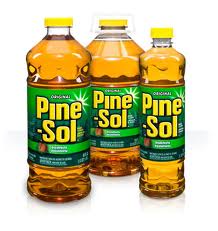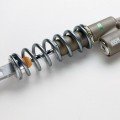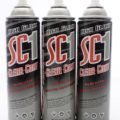 There’s a shade tree mechanic’s proverb that explains how to fix just about everything using only two items. If it should turn or spin and doesn’t, use WD-40; if it turns or spins and shouldn’t, use duct tape. There’s several ways to interpret this statement. One is that the person who said it has a simian intellect and fixes carnival rides for a living. Another is that the end justifies the means – whatever gets the job done. While I certainly believe in the right tool for the right job, it’s hard to argue with successful results. And defining what the right tool is can be open to interpretation. Case in point: if you need to remove years of built up gunk inside your carburetor, the right tool may be as close as the household cleaning isle of your local grocery store.
If you’re a do-it-yourselfer who likes to wrench on his own bike you might consider giving Pine Sol a try next time you need to deep clean your carb. Soaking it in a traditional carb dip will eat away all the gum deposits and varnish that have formed inside, leaving your carburetor shiny and clean. But carb dip contains very strong chemicals and thanks to our good friends at the EPA, it’s getting very expensive and harder to find.
Aerosol carb or brake cleaner will work too. But again, you’re using harsh chemicals and it takes several cans to really get everything clean. Not only is this method time consuming, but all that spraying is a real pain in the, uh, index finger. Wouldn’t it be better to let your carburetor soak?
Behold the power of Pine! An economical alternative to carb dip, Pine Sol contains wholesome natural ingredients like: Alkyl Alcohol Ethoxylates, Sodium Petroleum, and Isopropanol. There’s even a smidgen of Pine Oil in it for a clean fresh scent…kind of like a conifer urinal tablet.
When we first learned of this on an internet forum, we were a bit skeptical. So Dual Sport Alchemy’s top engineer took it upon himself to investigate this in our research and development laboratory. In other words, my friend Justin tried it in his garage.
After removing the carb from his XR600, Justin disassembled it; setting aside the gasket, float, fuel/air screw o-ring and any other non metallic parts. Soaking these parts in Pine Sol may not have had any detrimental effects but he decided not to chance it. Justin also pointed out that if your carburetor is old enough and funky enough that it needs to be dipped, its best just to replace all gaskets and o-rings anyway.
Next he took a suitable container (in this case a large coffee can) and placed the carb inside, pouring the entire bottle of Pine Sol over it. A 48 oz bottle wasn’t quite enough to entirely submerge his carburetor, so he was forced to top it off with a little water. Even after diluting it slightly, he estimated the solution was still about 95 % pure Pine Sol. Next came the easy part: leave it alone.
After soaking in the Pine Sol solution for a day and a half, Justin removed the carb and used an old soft bristled toothbrush to gently remove any lingering material. (Admin note: I’ve started requisitioning my kids’ old toothbrushes for things like this. The smaller brush heads allow them better access to tight spots and tiny areas.) Then he rinsed the carburetor in hot water, blew out all ports, jets , and orifices with compressed air, and allowed it to completely dry before reassembling.
This turned out to be a highly effective and economical alternative to traditional carb dip, and Justin was also left with enough Pine Sol for future uses…just maybe not household cleanings.
Thanks to the DIY pioneer who first discovered this trick, and to those who posted it on advrider.
There’s a shade tree mechanic’s proverb that explains how to fix just about everything using only two items. If it should turn or spin and doesn’t, use WD-40; if it turns or spins and shouldn’t, use duct tape. There’s several ways to interpret this statement. One is that the person who said it has a simian intellect and fixes carnival rides for a living. Another is that the end justifies the means – whatever gets the job done. While I certainly believe in the right tool for the right job, it’s hard to argue with successful results. And defining what the right tool is can be open to interpretation. Case in point: if you need to remove years of built up gunk inside your carburetor, the right tool may be as close as the household cleaning isle of your local grocery store.
If you’re a do-it-yourselfer who likes to wrench on his own bike you might consider giving Pine Sol a try next time you need to deep clean your carb. Soaking it in a traditional carb dip will eat away all the gum deposits and varnish that have formed inside, leaving your carburetor shiny and clean. But carb dip contains very strong chemicals and thanks to our good friends at the EPA, it’s getting very expensive and harder to find.
Aerosol carb or brake cleaner will work too. But again, you’re using harsh chemicals and it takes several cans to really get everything clean. Not only is this method time consuming, but all that spraying is a real pain in the, uh, index finger. Wouldn’t it be better to let your carburetor soak?
Behold the power of Pine! An economical alternative to carb dip, Pine Sol contains wholesome natural ingredients like: Alkyl Alcohol Ethoxylates, Sodium Petroleum, and Isopropanol. There’s even a smidgen of Pine Oil in it for a clean fresh scent…kind of like a conifer urinal tablet.
When we first learned of this on an internet forum, we were a bit skeptical. So Dual Sport Alchemy’s top engineer took it upon himself to investigate this in our research and development laboratory. In other words, my friend Justin tried it in his garage.
After removing the carb from his XR600, Justin disassembled it; setting aside the gasket, float, fuel/air screw o-ring and any other non metallic parts. Soaking these parts in Pine Sol may not have had any detrimental effects but he decided not to chance it. Justin also pointed out that if your carburetor is old enough and funky enough that it needs to be dipped, its best just to replace all gaskets and o-rings anyway.
Next he took a suitable container (in this case a large coffee can) and placed the carb inside, pouring the entire bottle of Pine Sol over it. A 48 oz bottle wasn’t quite enough to entirely submerge his carburetor, so he was forced to top it off with a little water. Even after diluting it slightly, he estimated the solution was still about 95 % pure Pine Sol. Next came the easy part: leave it alone.
After soaking in the Pine Sol solution for a day and a half, Justin removed the carb and used an old soft bristled toothbrush to gently remove any lingering material. (Admin note: I’ve started requisitioning my kids’ old toothbrushes for things like this. The smaller brush heads allow them better access to tight spots and tiny areas.) Then he rinsed the carburetor in hot water, blew out all ports, jets , and orifices with compressed air, and allowed it to completely dry before reassembling.
This turned out to be a highly effective and economical alternative to traditional carb dip, and Justin was also left with enough Pine Sol for future uses…just maybe not household cleanings.
Thanks to the DIY pioneer who first discovered this trick, and to those who posted it on advrider.Maintenance Tip: Pine Fresh Carb Dip
March 18, 2012
 There’s a shade tree mechanic’s proverb that explains how to fix just about everything using only two items. If it should turn or spin and doesn’t, use WD-40; if it turns or spins and shouldn’t, use duct tape. There’s several ways to interpret this statement. One is that the person who said it has a simian intellect and fixes carnival rides for a living. Another is that the end justifies the means – whatever gets the job done. While I certainly believe in the right tool for the right job, it’s hard to argue with successful results. And defining what the right tool is can be open to interpretation. Case in point: if you need to remove years of built up gunk inside your carburetor, the right tool may be as close as the household cleaning isle of your local grocery store.
If you’re a do-it-yourselfer who likes to wrench on his own bike you might consider giving Pine Sol a try next time you need to deep clean your carb. Soaking it in a traditional carb dip will eat away all the gum deposits and varnish that have formed inside, leaving your carburetor shiny and clean. But carb dip contains very strong chemicals and thanks to our good friends at the EPA, it’s getting very expensive and harder to find.
Aerosol carb or brake cleaner will work too. But again, you’re using harsh chemicals and it takes several cans to really get everything clean. Not only is this method time consuming, but all that spraying is a real pain in the, uh, index finger. Wouldn’t it be better to let your carburetor soak?
Behold the power of Pine! An economical alternative to carb dip, Pine Sol contains wholesome natural ingredients like: Alkyl Alcohol Ethoxylates, Sodium Petroleum, and Isopropanol. There’s even a smidgen of Pine Oil in it for a clean fresh scent…kind of like a conifer urinal tablet.
When we first learned of this on an internet forum, we were a bit skeptical. So Dual Sport Alchemy’s top engineer took it upon himself to investigate this in our research and development laboratory. In other words, my friend Justin tried it in his garage.
After removing the carb from his XR600, Justin disassembled it; setting aside the gasket, float, fuel/air screw o-ring and any other non metallic parts. Soaking these parts in Pine Sol may not have had any detrimental effects but he decided not to chance it. Justin also pointed out that if your carburetor is old enough and funky enough that it needs to be dipped, its best just to replace all gaskets and o-rings anyway.
Next he took a suitable container (in this case a large coffee can) and placed the carb inside, pouring the entire bottle of Pine Sol over it. A 48 oz bottle wasn’t quite enough to entirely submerge his carburetor, so he was forced to top it off with a little water. Even after diluting it slightly, he estimated the solution was still about 95 % pure Pine Sol. Next came the easy part: leave it alone.
After soaking in the Pine Sol solution for a day and a half, Justin removed the carb and used an old soft bristled toothbrush to gently remove any lingering material. (Admin note: I’ve started requisitioning my kids’ old toothbrushes for things like this. The smaller brush heads allow them better access to tight spots and tiny areas.) Then he rinsed the carburetor in hot water, blew out all ports, jets , and orifices with compressed air, and allowed it to completely dry before reassembling.
This turned out to be a highly effective and economical alternative to traditional carb dip, and Justin was also left with enough Pine Sol for future uses…just maybe not household cleanings.
Thanks to the DIY pioneer who first discovered this trick, and to those who posted it on advrider.
There’s a shade tree mechanic’s proverb that explains how to fix just about everything using only two items. If it should turn or spin and doesn’t, use WD-40; if it turns or spins and shouldn’t, use duct tape. There’s several ways to interpret this statement. One is that the person who said it has a simian intellect and fixes carnival rides for a living. Another is that the end justifies the means – whatever gets the job done. While I certainly believe in the right tool for the right job, it’s hard to argue with successful results. And defining what the right tool is can be open to interpretation. Case in point: if you need to remove years of built up gunk inside your carburetor, the right tool may be as close as the household cleaning isle of your local grocery store.
If you’re a do-it-yourselfer who likes to wrench on his own bike you might consider giving Pine Sol a try next time you need to deep clean your carb. Soaking it in a traditional carb dip will eat away all the gum deposits and varnish that have formed inside, leaving your carburetor shiny and clean. But carb dip contains very strong chemicals and thanks to our good friends at the EPA, it’s getting very expensive and harder to find.
Aerosol carb or brake cleaner will work too. But again, you’re using harsh chemicals and it takes several cans to really get everything clean. Not only is this method time consuming, but all that spraying is a real pain in the, uh, index finger. Wouldn’t it be better to let your carburetor soak?
Behold the power of Pine! An economical alternative to carb dip, Pine Sol contains wholesome natural ingredients like: Alkyl Alcohol Ethoxylates, Sodium Petroleum, and Isopropanol. There’s even a smidgen of Pine Oil in it for a clean fresh scent…kind of like a conifer urinal tablet.
When we first learned of this on an internet forum, we were a bit skeptical. So Dual Sport Alchemy’s top engineer took it upon himself to investigate this in our research and development laboratory. In other words, my friend Justin tried it in his garage.
After removing the carb from his XR600, Justin disassembled it; setting aside the gasket, float, fuel/air screw o-ring and any other non metallic parts. Soaking these parts in Pine Sol may not have had any detrimental effects but he decided not to chance it. Justin also pointed out that if your carburetor is old enough and funky enough that it needs to be dipped, its best just to replace all gaskets and o-rings anyway.
Next he took a suitable container (in this case a large coffee can) and placed the carb inside, pouring the entire bottle of Pine Sol over it. A 48 oz bottle wasn’t quite enough to entirely submerge his carburetor, so he was forced to top it off with a little water. Even after diluting it slightly, he estimated the solution was still about 95 % pure Pine Sol. Next came the easy part: leave it alone.
After soaking in the Pine Sol solution for a day and a half, Justin removed the carb and used an old soft bristled toothbrush to gently remove any lingering material. (Admin note: I’ve started requisitioning my kids’ old toothbrushes for things like this. The smaller brush heads allow them better access to tight spots and tiny areas.) Then he rinsed the carburetor in hot water, blew out all ports, jets , and orifices with compressed air, and allowed it to completely dry before reassembling.
This turned out to be a highly effective and economical alternative to traditional carb dip, and Justin was also left with enough Pine Sol for future uses…just maybe not household cleanings.
Thanks to the DIY pioneer who first discovered this trick, and to those who posted it on advrider.




